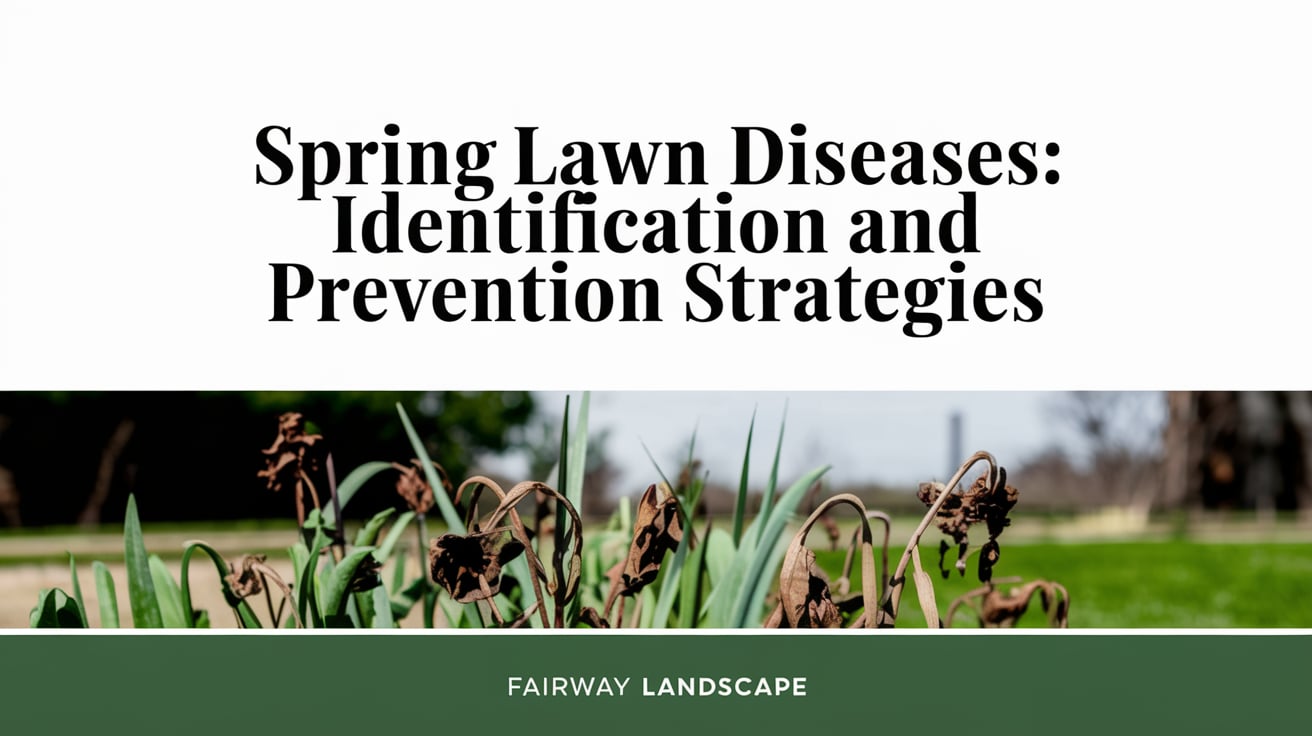As temperatures rise and spring moisture increases across Maryland, conditions become ideal for various lawn diseases that can quickly transform promising spring green-up into disappointing brown patches. These fungal pathogens thrive in the specific temperature and moisture conditions common during our spring transition, making this season particularly challenging for lawn health. Understanding the most common spring lawn diseases, their identifying characteristics, and effective prevention strategies can help protect your turf from these damaging outbreaks and ensure a healthy lawn throughout the growing season.

Understanding Spring Disease Pressure in Maryland Lawns
Weather pattern influences create disease-favorable conditions. The combination of warming temperatures and frequent rainfall typical of Maryland springs creates perfect environments for fungal pathogens. Our professional turf management programs monitor these conditions and implement preventative measures during high-risk periods rather than waiting for visible symptoms to appear.
Stressed turf shows increased disease susceptibility. Lawns weakened by winter damage, poor nutrition, or improper cultural practices show dramatically higher disease incidence than healthy, properly maintained turf. Our comprehensive lawn health services address these underlying stress factors that often predispose lawns to disease outbreaks.
Pathogen life cycles align with seasonal transitions. Many lawn diseases remain dormant during winter months, becoming active precisely when lawns begin spring growth. This timing creates particularly damaging scenarios where emerging turf immediately encounters active pathogens. Our spring lawn disease prevention strategies account for these life cycle patterns that make early intervention critical.
Identifying Common Spring Lawn Diseases
Red thread presents as pinkish-red patches with visible thread-like structures. This distinctive disease appears during cool, wet spring conditions, particularly in lawns with low nitrogen levels. While rarely fatal to turf, its unsightly appearance concerns many homeowners. Our diagnostic expertise distinguishes this relatively benign condition from more serious diseases requiring aggressive intervention.
Leaf spot manifests as small, dark lesions on grass blades that expand into larger patches. As this disease progresses, infected areas thin and can eventually die, creating bare patches throughout the lawn. Our lawn fungus treatment programs include both preventative measures during high-risk periods and curative approaches when symptoms appear.
Snow mold damage becomes visible as snow melts, appearing as circular patches of matted, straw-colored turf. While the fungus becomes inactive as temperatures rise, the damage remains visible until new growth fills in affected areas. Our early spring treatments accelerate recovery from this winter-initiated disease that often concerns homeowners during spring green-up.
Cultural Practices for Disease Prevention
Mowing height adjustments significantly impact disease development. Maintaining proper mowing height—typically 3-4 inches for most cool-season grasses in our region—creates more resilient turf with deeper root systems and better disease resistance. Our professional turf management guidelines include specific height recommendations based on your grass type and seasonal conditions.
Irrigation timing minimizes leaf wetness periods. Watering during early morning hours allows foliage to dry quickly, reducing the prolonged moisture that many fungal pathogens require. Our comprehensive lawn care recommendations include these crucial timing considerations that dramatically affect disease pressure.
Thatch management prevents favorable disease environments. Excessive thatch creates ideal habitat for many pathogens while restricting water and air movement to root zones. Our professional lawn health services include appropriate dethatching and aeration that maintain optimal thatch levels for disease resistance.
Nutrition Strategies for Disease-Resistant Turf
Balanced fertility prevents both deficiency and excess problems. While inadequate nutrition weakens turf and increases disease susceptibility, excessive nitrogen can actually promote certain diseases by creating lush, tender growth. Our precision fertilization programs provide balanced nutrition that strengthens disease resistance without creating vulnerable conditions.
Slow-release formulations optimize nutrient availability. Professional-grade fertilizers with controlled-release technologies provide steady nutrition that supports consistent growth and maximum disease resistance. Our lawn health services utilize these advanced products rather than the surge-and-crash pattern often seen with consumer-grade fertilizers.
Micronutrient supplementation addresses specific deficiencies. Beyond primary nutrients, elements like iron, manganese, and zinc play crucial roles in disease resistance mechanisms. Our comprehensive nutrition programs include these essential micronutrients when soil testing indicates deficiencies that might compromise disease resistance.
Professional Preventative Treatments
Fungicide timing maximizes effectiveness while minimizing applications. Preventative applications before disease development provide significantly better control than curative treatments after symptoms appear. Our professional lawn fungus treatment programs utilize weather monitoring and disease modeling to time these preventative applications precisely when conditions favor disease development.
Rotation strategies prevent resistance development. Different fungicide classes affect pathogens through different mechanisms, and rotating these classes prevents pathogens from developing resistance. Our comprehensive disease management includes appropriate product rotation that maintains long-term effectiveness while providing immediate protection.
Application technology ensures proper coverage and penetration. Professional equipment and techniques ensure fungicides reach target areas effectively, particularly important for diseases affecting crown and root zones. Our specialized application methods achieve results simply not possible with typical homeowner equipment and products.
Disease-Resistant Grass Varieties for Maryland Lawns
Endophyte-enhanced varieties offer natural insect and disease resistance. Certain turfgrass varieties contain beneficial fungi that produce compounds deterring both insects and diseases. Our renovation and overseeding programs utilize these enhanced varieties that provide continuous protection without chemical inputs.
Improved cultivars demonstrate significant resistance differences. Modern turfgrass breeding has created varieties with dramatically improved disease resistance compared to older types. Our professional seed selection includes these improved cultivars specifically chosen for resistance to diseases common in our region.
Blended seed mixtures provide resilience through diversity. Different grass varieties show resistance to different diseases, and blended lawns leverage this variation to prevent complete susceptibility to any single pathogen. Our customized seed blends include complementary varieties that create this protective diversity.
Recovery Strategies When Disease Occurs
Damage assessment determines appropriate intervention. Different diseases and severity levels require different recovery approaches. Our professional evaluation distinguishes between conditions that will recover with cultural practices alone versus those requiring more aggressive intervention.
Curative treatments target active infections. When preventative measures fail or weren’t implemented, prompt curative treatment can limit damage spread. Our comprehensive lawn fungus treatment programs include both preventative and curative options appropriate for specific disease conditions.
Renovation techniques restore severely damaged areas. For lawns with extensive disease damage, partial renovation through overseeding or sodding may provide the most efficient recovery path. Our professional lawn health services include these targeted renovation approaches that restore damaged areas while preserving healthy turf.
Long-Term Disease Management Planning
Site modification addresses environmental risk factors. Properties with shade patterns, drainage issues, or air circulation problems often experience recurring disease pressure regardless of chemical treatments. Our comprehensive management approach includes site modifications that address these underlying environmental factors.
Maintenance calendar adjustments align practices with disease prevention. Timing of core cultural practices—from aeration and overseeding to fertilization and irrigation—significantly impacts disease development. Our professional turf management programs coordinate these activities to minimize disease-favorable conditions while maximizing turf health.
Monitoring programs identify problems before visible symptoms. Regular professional inspection can detect early disease indicators before damage becomes apparent to homeowners. Our proactive maintenance services include this crucial early detection that allows intervention before diseases cause significant damage.
Integrated Approaches for Sustainable Results
Biological control options supplement conventional treatments. Various beneficial microorganisms compete with or directly attack lawn pathogens, providing supplemental protection with minimal environmental impact. Our comprehensive disease management incorporates these biological approaches when appropriate for specific conditions and client preferences.
Soil health management builds natural disease suppression. Healthy soils with diverse microbial populations naturally suppress many turf pathogens. Our holistic lawn health services include soil building practices that develop these suppressive characteristics for long-term disease resistance.
Chemical intervention thresholds balance protection and sustainability. Rather than calendar-based preventative applications, integrated approaches establish action thresholds based on disease pressure, lawn use, and aesthetic expectations. Our customized programs establish these appropriate thresholds that provide necessary protection without unnecessary treatments.
Partner with Fairway Landscape for Complete Lawn Health
At Fairway Landscape, we offer comprehensive lawn health services throughout Harford and Cecil Counties. Our professional approach combines preventative cultural practices, appropriate nutrition, and targeted interventions to create disease-resistant lawns that maintain their beauty throughout the growing season. From regular maintenance programs to specialized disease management, our services address your property’s specific needs with sustainable, effective solutions.
Contact us today to schedule your professional lawn assessment. Our experienced turf specialists will evaluate your lawn’s current condition and disease risk factors, developing a customized management plan that protects your turf from spring diseases while promoting overall lawn health. Don’t let fungal pathogens undermine your lawn’s potential—partner with Fairway Landscape for professional protection that ensures a beautiful, healthy lawn all season long.

